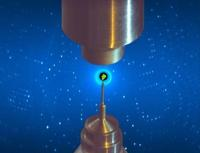Speaker
Description
Lactoferrin (Lf) is a non-heme protein known for its ability to naturally bind tightly Fe3+ ions in various physiological environments. Therefore, Lf has a significant role in the processes of iron regulation at the cellular level and organize the specific and non-specific immune response in the body.
The conformational changes within the protein structure caused by the iron-binding are continuously studied. Resolving the iron binding-release mechanism and study of physicochemical factors influenced by it will help gain a wider understanding of its biological and medical properties.
The presented study was addressed towards observing the conformation stability of human lactoferrin influenced by the temperature, ph effect and salt concentration in solution by small angle neutron scattering (SANS).
The SANS study allowed us to structurally differentiate between the iron-free Lf (apo-Lf) and iron-saturated Lf (holo-Lf) in solution [1]. The 3-dimensional models computed for both forms of human lactoferrin also show visible differences, both having a more compact conformation compared to the high-resolution structure.
[1] Anghel, L., Radulescu, A. & Erhan, R.V. Structural aspects of human lactoferrin in the iron-binding process studied by molecular dynamics and small-angle neutron scattering. Eur. Phys. J. E 41, 109 (2018). https://doi.org/10.1140/epje/i2018-11720-x

